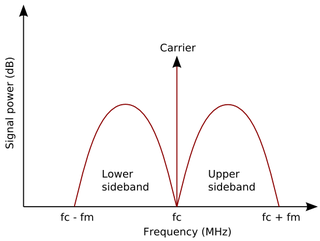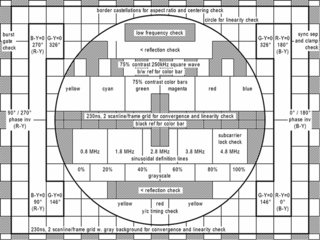
In telecommunications and signal processing, frequency modulation (FM) is the encoding of information in a carrier wave by varying the instantaneous frequency of the wave.
In electronics and telecommunications, modulation is the process of varying one or more properties of a periodic waveform, called the carrier signal, with a modulating signal that typically contains information to be transmitted. Most radio systems in the 20th century used frequency modulation (FM) or amplitude modulation (AM) for radio broadcast.

In radio communications, single-sideband modulation (SSB) or single-sideband suppressed-carrier modulation (SSB-SC) is a type of modulation, used to transmit information, such as an audio signal, by radio waves. A refinement of amplitude modulation, it uses transmitter power and bandwidth more efficiently. Amplitude modulation produces an output signal the bandwidth of which is twice the maximum frequency of the original baseband signal. Single-sideband modulation avoids this bandwidth increase, and the power wasted on a carrier, at the cost of increased device complexity and more difficult tuning at the receiver.
A Compatible sideband transmission, also known as amplitude modulation equivalent (AME) or Single sideband-reduced carrier (SSB-RC), is a type of single sideband RF modulation in which the carrier is deliberately reinserted at a lower level after its normal suppression to permit reception by conventional AM receivers.
Double-sideband suppressed-carrier transmission (DSB-SC) is transmission in which frequencies produced by amplitude modulation (AM) are symmetrically spaced above and below the carrier frequency and the carrier level is reduced to the lowest practical level, ideally being completely suppressed.

In radio communications, a sideband is a band of frequencies higher than or lower than the carrier frequency, containing power as a result of the modulation process. The sidebands carry the information (modulation) transmitted by the signal. The sidebands consist of all the Fourier components of the modulated signal except the carrier. All forms of modulation produce sidebands.
Reduced-carrier transmission is an amplitude modulation (AM) transmission in which the carrier signal level is reduced to reduce wasted electrical power. Suppressed-carrier transmission is a special case in which the carrier level is reduced below that required for demodulation by a normal receiver.
In telecommunication systems, Carrier frequency is a technical term used to indicate:

Pulse-amplitude modulation (PAM), is a form of signal modulation where the message information is encoded in the amplitude of a series of signal pulses. It is an analog pulse modulation scheme in which the amplitudes of a train of carrier pulses are varied according to the sample value of the message signal. Demodulation is performed by detecting the amplitude level of the carrier at every single period.

In telecommunications, a carrier wave, carrier signal, or just carrier, is a waveform that is modulated (modified) with an input signal for the purpose of conveying information. This carrier wave usually has a much higher frequency than the input signal does. The purpose of the carrier is usually either to transmit the information through space as an electromagnetic wave, or to allow several carriers at different frequencies to share a common physical transmission medium by frequency division multiplexing. The term is also used for an unmodulated emission in the absence of any modulating signal.
Independent sideband (ISB) is an AM single sideband mode which is used with some AM radio transmissions. Normally each sideband carries identical information, but ISB modulates two different input signals — one on the upper sideband, the other on the lower sideband. This is used in some kinds of AM stereo, but is generally otherwise prohibited in the U.S. by the FCC.

Amateur television (ATV) is the transmission of broadcast quality video and audio over the wide range of frequencies of radio waves allocated for radio amateur (Ham) use. ATV is used for non-commercial experimentation, pleasure, and public service events. Ham TV stations were on the air in many cities before commercial television stations came on the air. Various transmission standards are used, these include the broadcast transmission standards of NTSC in North America and Japan, and PAL or SECAM elsewhere, utilizing the full refresh rates of those standards. ATV includes the study of building of such transmitters and receivers, and the study of radio propagation of signals travelling between transmitting and receiving stations.
A figure of merit is a quantity used to characterize the performance of a device, system or method, relative to its alternatives.
A radar system uses a radio frequency electromagnetic signal reflected from a target to determine information about that target. In any radar system, the signal transmitted and received will exhibit many of the characteristics described below.
In 1933, Edwin H. Armstrong patented a method for generating frequency modulation of radio signals. The Armstrong method generates a double sideband suppressed carrier signal, phase shifts this signal, and then reinserts the carrier to produce a frequency modulated signal.
A Nyquist filter is an electronic filter used in TV receivers to equalize the video characteristics. The filter is named after the Swedish–US engineer Harry Nyquist (1889–1976).
The intercarrier method is a system in television that reduces the cost of transmitters and receiver sets by processing audio and video signals together and minimizing the number of separate stages for audio and video signals.
CCIR System A was the 405 line analog broadcast television system broadcast in the UK and Ireland. CCIR service was discontinued in 1985.







